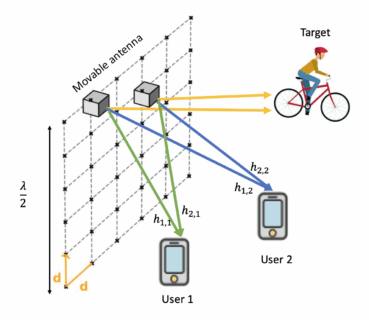Master Thesis — Movable Intelligent Surfaces: Codebook-Based Control and Physics-Aware Modeling for 6G Reconfigurable Environments
Topic:
Reconfigurable intelligent surfaces (RIS) have emerged as a promising technology to provide a cost-effective, energy-efficient, and low-complexity means of enhancing wireless communication performance. However, the increasingly sophisticated hardware designs required for advanced RIS architectures such as dynamic or active RIS often depend on further breakthroughs in electronics and materials science, making their large-scale deployment challenging.
Although conventional dynamic RISs can, in theory, offer remarkable beamforming flexibility and performance gains, this comes at the cost of rapid, frequent, and element-wise reconfiguration, across thousands of controllable phase shifters. Such fine grained control imposes stringent timing, synchronization, and signaling demands on the controller hardware while increasing power consumption and computational burden. As a result, the idealized adaptability of dynamic RISs is difficult to achieve in practice, leading to a fundamental trade-off between performance, complexity, and cost.
To overcome these limitations, in this thesis the new concept of movable intelligent surfaces (MIS) should be studied. Instead of relying solely on electronic phase tuning, an MIS exploits mechanical or structural mobility of its tiles or sub-arrays to dynamically reshape the propagation environment. By slightly displacing, tilting, or rotating parts of the surface, the MIS can achieve spatial diversity and beam steering gains comparable to dynamic RIS, but with significantly fewer active components. This hybrid approach combines the low-power benefits of passive RIS with the adaptability of movable antennas, introducing an additional degree of freedom for environmental reconfiguration while reducing hardware complexity, control overhead, and energy consumption.
Guidelines for the project:
- Conducting a literature survey on RIS, and movable antennas.
- Developing a physics-based model and scalable optimization framework for MIS.
- Simulation of the proposed algorithm in MATLAB.
If successful, this work may lead to a journal and/or a conference paper.
Prerequisites:
- Interest in communications and signal processing
- Basic knowledge of digital and mobile communication systems(e.g., gained in the courses “Digital Communications”, “Mobile Communications”).
- Experience in MATLAB.
The complete project description can be found here. In case you are interested in pursuing this thesis, please contact Ata Khalili (ata.khalili@fau.de).
